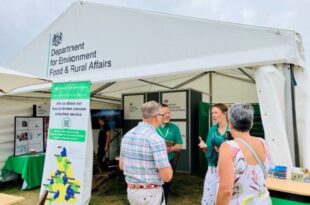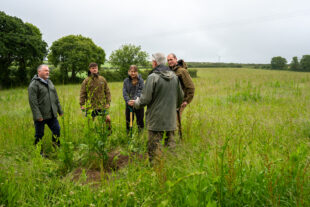https://defrafarming.blog.gov.uk/maintain-species-rich-grassland/
Maintain species-rich grassland
The guidance on this page is for SFI pilot participants only. Please visit GOV.UK for the official Sustainable Farming Incentive scheme guidance.
Find out how land managers can provide habitat for plants and invertebrates by maintaining species-rich grassland.
If you’re completing this action as part of the Sustainable Farming Incentive pilot, how you do it is up to you.
The advice on this page can help you get better environmental and business benefits, but you do not have to follow it to get paid.
Why species-rich grassland is important
Species-rich grassland is open, grassy habitat that is normally maintained by traditional grazing and cutting methods. Grassland is species-rich if it has:
- more than 15 plant species per square metre
- more than 30% cover of wildflowers and sedges (excluding white clover, creeping buttercup and injurious weeds)
- less than 10% cover of white clover and perennial rye grass
The type of species-rich grassland depends on location, underlying geology, soil pH, its management and history. The different types of species-rich grassland are:
- lowland meadows
- upland hay meadows
- lowland calcareous grassland
- upland calcareous grassland
- lowland acid grassland
- purple moor-grass and rush pastures
- calaminarian grassland
Use MAGIC to check if you have priority habitat grassland and what type of grassland it is. You can find some types of species-rich grassland alongside other habitats, like scrub, fen or heath.
Species-rich grassland can cover individual fields or larger areas, like downland or upland enclosures. Larger grasslands provide more habitat for wildlife and can cope better with the effects of climate change.
On the land surrounding small sites, you can create new species-rich grassland or manage it as low-input grassland. This will:
- make small sites bigger and provide more habitat
- buffer sites from the effects of nutrient runoff from surrounding farmland
- connect small sites to other species-rich grassland or habitats, which allows wildlife to move across the landscape
Find out how to restore grassland which does not meet the species-rich criteria, but is priority habitat grassland or has:
- 9 to 15 plant species per square metre
- more than 10% cover of wildflowers and sedges (excluding white clover, creeping buttercup and injurious weeds)
- less than 30% cover of white clover and perennial rye grass
Use MAGIC to check if you have priority habitat grassland.
Without regular grazing or cutting, coarse grasses and scrub will smother wildflowers. This leads to the grassland becoming scrubby and eventually turning into woodland.
Benefits of species-rich grassland
Species-rich grassland is rare and home to a large number and variety of wildflowers. Each grassland supports a unique set of species, including many threatened species of plants, invertebrates and birds.
Species-rich grassland:
- keeps soil healthy and carbon-rich
- protects soil from erosion
- provides a range of forage for livestock
- is part of the character of a landscape
- can be part of our cultural heritage where traditions and skills are maintained, like haymaking
How to maintain species-rich grassland
Aim to maintain the number and variety of plant species in species-rich grassland. You need to graze, cut for hay or cut species-rich grassland to maintain the grassy vegetation. You can use a mix of these methods.
Grazing will benefit most species-rich grassland and is usually needed to manage it. Continue hay cutting where grasslands are already managed as hay meadows or have traditionally been hay meadows. You can cut species-rich grasslands where grazing is not possible or practical.
You’ll need to manage each type of species-rich grassland differently to provide the best conditions for its plant community and other wildlife.
To avoid damage to species-rich grassland, do not:
- plough or reseed
- apply fertiliser, except to replace nutrients removed through haymaking
- change any drainage, other than cleaning and maintenance
- use pesticides
- use herbicides, except in limited situations where you need to manage injurious weeds or invasive non-native species
- change the soil pH
- compact the soil by grazing or using machinery when the soil is too wet
- supplementary feed livestock
Graze with livestock
You can use grazing livestock to create a mix of vegetation heights.
Different vegetation heights provide a wider range of suitable conditions for more species of wildflowers and invertebrates. Where the vegetation is short, the hooves of livestock should create small areas of bare ground. This provides somewhere for wildflower seed to germinate and for invertebrates to warm up and burrow.
Cattle or native ponies are good at creating a mix of vegetation heights. Sheep can be useful on some grasslands where you need to create short vegetation, like lowland acid grassland.
You may need to remove livestock for a period in spring or summer to allow plants to flower and set seed. Livestock, particularly sheep, will selectively graze flowers and stop them producing seed. You can start grazing again once most plants have flowered and set seed.
Make hay
Find out how to make field dried hay and aftermath graze on species-rich grassland. Haymaking after plants have flowered and set seed helps to create and maintain a wide variety of plant species. Species-rich grasslands are usually grazed following a hay cut.
Cut species-rich grassland
Find out how to cut species-rich grassland to create a mix of vegetation heights by cutting patches at different heights and times.
How to maintain lowland meadows
You’ll find lowland meadows on free-draining, neutral soils. Lowland meadows are the most common type of species-rich grassland and vary widely across the country. They include floodplain meadows, which are seasonally flooded and fertilised by floodwater.
A lowland meadow in good condition will have wildflowers like yellow-rattle, bird’s-foot-trefoil and common knapweed that flower and set seed each year.
A floodplain meadow in good condition will have:
- tall, moisture-loving wildflowers like great burnet, meadowsweet and pepper saxifrage
- maintained surface drainage that allows water to flow freely back to watercourses after a flood
You can manage lowland meadows as permanent pasture by grazing or by hay cutting and aftermath grazing. Aim for vegetation between 5cm and 15cm on average through the summer, unless the grassland is shut up for hay.
You may see birds like skylarks and a wide range of bees, butterflies and other invertebrates.
How to maintain upland hay meadows
You’ll find upland hay meadows on enclosed land between 200 metres and 400 metres above sea level.
If grazing in spring, maintain the vegetation at least 5cm tall. After cutting hay, graze until the vegetation is on average between 5cm and 10cm tall.
Hay meadows in good condition are cut for hay and have:
- wildflowers like pignut, great burnet and meadowsweet that flower and set seed each year
- more than 50% cover of wildflowers and sedges
- no more than 50% cover of rushes
- a mix of vegetation heights while livestock are grazing the grassland
You may see birds like skylarks or curlews and a wide range of bees, butterflies and other invertebrates.
How to maintain lowland calcareous grassland
You’ll find lowland calcareous grassland on chalk or limestone soils. It’s also known as chalk or limestone grassland and by local names like wolds or downs.
Lowland calcareous grassland in good condition is usually grazed and will have:
- wildflowers like bird’s-foot-trefoil, lady’s bedstraw and common rock-rose that flower and set seed each year
- herbs, like wild thyme, basil and marjoram
- fewer coarse grasses, like tor-grass which can smother wildflowers
- vegetation that is on average 5cm to 15cm tall in July and August
- vegetation that is on average 2cm to 7cm tall by the time you remove livestock in spring
- small patches of bare ground with mosses and lichens
You might see:
- rocky outcrops and chalk or limestone pebbles
- ant hills of the yellow meadow ant
- scattered scrub of different ages
- birds like stone curlews
- butterflies like dingy skippers and brown argus
How to maintain upland calcareous grassland
You’ll find upland calcareous grassland on shallow soils where hard calcareous rock, like limestone, is close to the surface. This rock is sometimes exposed as limestone pavement or rock outcrops and scree. Upland calcareous grassland is usually above an altitude of 250 metres.
Upland calcareous grassland in good condition is usually grazed and will have:
- short, springy turf with lots of mosses and fine grasses, like blue moor-grass
- wildflowers like horseshoe vetch, harebell and common rock-rose that flower and set seed each year
- a mix of long grass over 10cm and shorter patches less than 5cm
- no undesirable species, like common nettle, false oat-grass or injurious weeds
How to maintain lowland acid grassland
You’ll find lowland acid grassland on nutrient-poor, free-draining soils over acidic rocks, sands and gravels. It’s often alongside heath, scrub and woodland habitats. It does not include areas of acid grassland on open moorland or in enclosed upland fringes.
Lowland acid grassland in good condition is usually grazed and will have:
- wildflowers like tormentil, heath bedstraw, harebell and sheep’s sorrel that flower and set seed each year
- a variety of grasses, like sheep’s fescue, common bent and wavy hair-grass
- up to 10% bare ground for invertebrates to burrow into
- vegetation less than 10cm tall throughout the year
On parched and lichen dominated acid grassland, aim for a vegetation height of 5cm or less.
You may see invertebrates like mining bees and small heath butterflies, or birds like stone curlews and woodlarks.
How to maintain purple moor-grass and rush pasture
These are wet, tussocky grasslands on permanently wet but not waterlogged soil. They are on neutral to acid soils and sometimes peaty soils that get a lot of rain. You may know them by local names like culm grassland, wet lawns, fen meadows or litter meadows.
Purple moor-grass and rush pasture in good condition will have:
- abundant purple moor-grass or jointed rushes
- wildflowers like ragged-robin, devil’s-bit scabious and lesser spearwort that flower and set seed each year
- no more than 25% cover of large sedges
- no more than 20% cover of large grasses like reed and tufted hair-grass
- vegetation that is 8cm to 25cm tall by October
- a water table at the surface in winter and 2cm to 48cm below the surface in summer
You may see birds like curlews or snipe and invertebrates like marsh fritillary or brown hairstreak butterflies.
Sheep are not suitable for purple moor-grass and rush pasture. They will graze the grassland too short and the ground will be too wet for them. Remove livestock during winter and wet periods so that livestock do not poach the wet ground.
How to maintain calaminarian grassland
You can find calaminarian grassland on soils with high levels of heavy metals like zinc and lead. Most plants cannot tolerate these toxic conditions, but some can thrive. It’s mostly found near historic mining sites which brought metal-rich material to the surface.
Calaminarian grassland in good condition will have:
- short vegetation including fine-leaved grasses, flowers, mosses and lichens
- wildflowers like alpine penny-cress, sea campion and thrift that flower and set seed each year
- between 20% and 90% cover of lichens and bare ground, including cobbles and gravels
Graze with sheep to maintain vegetation that is on average 5cm or less. Rabbits can also graze the grassland short enough.
Some calaminarian grasslands have metal concentrations too high for livestock to safely graze. Without grazing, you’ll need to remove scrub to maintain the grassland.
Over time, metal-rich soils can become buried by topsoil. You’ll need to contact Natural England for specialist advice on how to re-expose the metal-rich soils.
Manage weeds and scrub
You should control injurious weeds and nettles if they cover more than 5% of species-rich grassland. They are food sources for invertebrates and birds but can smother wildflowers if allowed to spread.
Some rush species can smother wildflowers and reduce the grazing quality of grassland. If you have more than 10% cover, find out if you should control rushes in species-rich grassland.
Patches of scrub and trees in grassland provide other habitat for invertebrates and birds. Where there is scrub, it should be scattered across the grassland and cover between 5% and 10%. Scrub cover should be lower on:
- lowland wet grasslands for birds
- historic features in grassland
Species-rich grassland is a rare habitat, so you should not let scrub spread onto it. Find out how to manage scrub and scrub mosaics.



